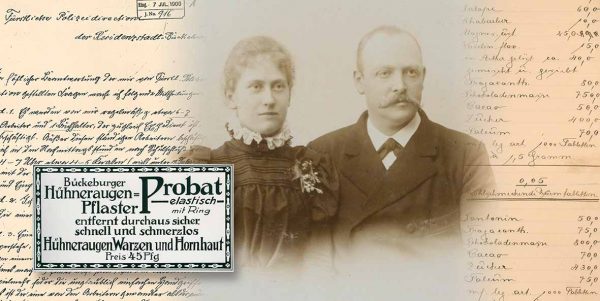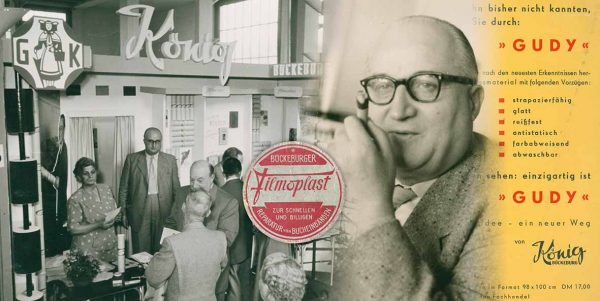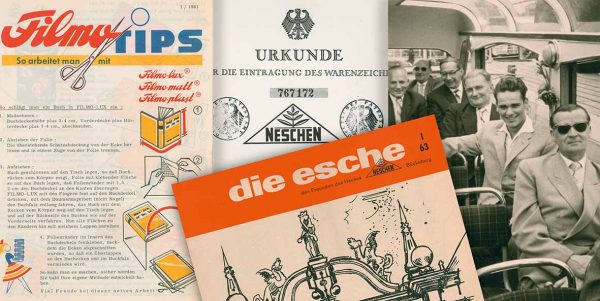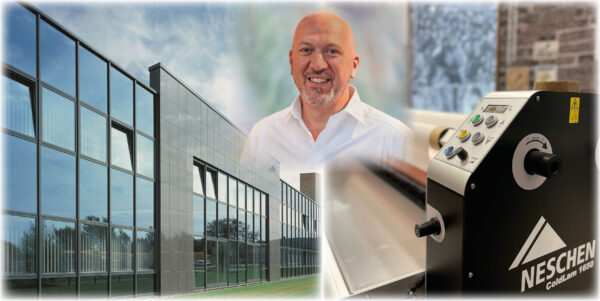135 Years of Ideas – From a humble band-aid factory to an internationally renowned visual media manufacturer
Today, Neschen Coating GmbH is renowned worldwide as an experienced manufacturer of self-adhesive films and printable media. However, 135 years ago, the company started with the manufacturing of India rubber plasters and wound dressings. In 1889, it was the apothecary Georg König who founded a factory for pharmaceutical preparations and thus established the beginning of the internationally renowned company from Bückeburg. On the first floor of the Court Pharmacy in the heart of the city and later on in a multistory factory, extension medical plasters, ointments and elastic capsules were produced that would later become famous.
After the Second World War, in the face of an increasingly competitive plaster market, the first self-adhesive films for book protection were produced. A new era started when industrialist Hans Neschen joined the company that would later bear his name. He joined a paralyzed company suffering from the aftermath of the Second World War and, following successful experiments with synthetic resin films, converted the company’s product portfolio. Thus followed the change from “Bückeburger Hühneraugenpflaster” (Bückeburg corn plaster) to “Bückeburger Buchhaut” (Bückeburg book cover).
Quickly, the films made a name for themselves and were sold by the millions at home and abroad. Foreign subsidiaries and participation at trade shows supported the expansion of the company. Soon, Neschen grew out of its location in downtown Bückeburg. Between 1965 and 1988, the company purchased land and established two factories, on the east side and west side of the city, from where Neschen operated until 2018. Due to restructuring of the company, the two plants were later merged, making the newer plant in eastern Bückeburg Neschen’s main location from 2019 on. In addition to self-adhesive films for book protection, the company engaged in the development of transfer adhesives and films for the finishing of photographs, processing machines for in-house production methods and transportable presentation systems. The next years would see many more innovative Neschen products, manufactured at the company headquarters in the former residential city of Bückeburg – where it all began 130 years ago.
1889 – 1914



PHASE 1
Court pharmacist Georg König and the medical plaster factory
1889
Foundation of “Fabrik pharmazeutischer Präparate” (Factory for pharmaceutical preparations) on the upper floor of the Court Pharmacy at Marktplatz in Bückeburg by apothecary Georg König. Production of different medical India rubber and dressing plasters, such as the renowned Bückeburger Hühneraugenpflaster “Probat” (Bückeburg corn plaster “Probat”).
1891
Company founder Georg König presents the first price list for his “Fabrik pharmaceutischer Kautschuk- and Guttapercha-Präparate“ (Factory for pharmaceutical India Rubber and guttapercha preparations) Next to wound plasters, ready-packaged medicine is listed.
1900
At the turn of the century, more than 4.5 million packages of Georg Königs Bückeburg corn plaster (Georg Königs Bückeburger Hühneraugenpflaster) were sold at home and abroad.
1905
Construction of a factory and administration building behind the Court Pharmacy.
1914
Dr. Wilhelm Kroseberg and Ernst Pfannenberg acquire the company and continue to operate as an open trading company.
1914 – 1946
PHASE 2
Contemporary history complicates medical plaster production
1914
Growing demand by the military for wound dressings has to be met although, due to the war, there is scarcity of raw materials. Production with insufficient raw material affects adhesion of plasters.
1919
In order to preserve the plaster factory, Wilhelm Kroseberg has to expand the product portfolio by introducing preparations required in the post war period.
1921
Dr. Wilhelm Kroseberg designs the first hallmark for the company.
1936
The launch of the film Typoplast marks the moment when, in addition to the pharmaceutical dressings, India rubber adhesive films for commercial and industrial applications are offered for the first time.
1945
The collapse after the Second World War shook the solidly run company to the core.



1946 – 1960



PHASE 3
New paths by manufacturing self-adhesive films
1946
Hans Neschen joins the company that nowadays bears his name: Neschen AG.
1949
Conversion of the production to self-adhesive films for book protection and book
repair. The synthetic resin films Filmolux, Filmomatt, Filmoplast and Gudy will conquer international markets in the following years.
1956
Establishment of library services as all-round service for lending libraries.
1957
The first foreign subsidiary is established in Amsterdam. Shortly afterwards, subsidiaries are established in Vienna, Brussels, Paris and Tokyo.
1959
Entrepreneur Hans Neschen converts the company Georg König GmbH to sole proprietorship Hans Neschen KG. The same year plaster production ultimately ceases.
1960– 1989
PHASE 4
Worldwide expansion course for the company
1962
The Neschen triangle is introduced as new company logo.
1965
Alexander Schreiber, son-in-law of Hans Neschen, takes over sole management.
1966
Relocation to the newly built factory and administration building at the western part of Bückeburg.
1969
With delivery of the first cold-laminating machines the company from Bückeburg revolutionized rearing and finishing of prints and photographs.
1975
Two long-term employees, Otto Denstorff and Helmut Fahlbusch take over management of the company.
1988
Another subsidiary is established in England. A few years later, establishment of subsidiaries in America, Italy, Spain, Portugal and Hungary will follow.



1989 – 1996



PHASE 5
Changes and rises
1989
A second factory for the company, to be built in several steps, sprouts in the new industrial area at the eastern part of Bückeburg.
1991
Gudrun Schönemann and Hans-Ulrich Schreiber, Hans Neschen’s grandchildren take over management and introduce a new company logo.
1995
Rolf Zinn, who since September 1994 leads the company, acquires all shares of the company in 1995 and takes over as Managing Partner.
1996
The company refines the “Bückeburger Verfahren” (Bückeburg procedure) for automatic mass conservation and saves millons of documents from decay.
1996 – 2016
PHASE 6
„New NESCHEN“
2001
The biggest acquisition in the company’s history is executed by the takeover of the renowned graphics department from Hunt Corporation branded “Seal”.
2013
Restructuring expert Henrik Felbier is appointed CEO of Neschen AG. The same year, the company separates from its US subsidiaries that were acquired in 2001 and the associated production sites in America and in England. The change to “New Neschen” is also reflected in a revised company logo.
2014
The year of its 125th anniversary sees the company well prepared for the future thanks to its decadeslong industry knowledge and its many different high-quality and innovative products.
2016
Neschen enters the future strengthened under the new owner BLUE CAP AG and with new managing director Kai Tittgemeyer.



2017-2019



PHASE 7
„NESCHEN expansion“
2017
Starting in April 2017, sales in Germany are handled by the Filmolux Deutschland GmbH, an independent distributor of the Neschen product portfolio and selected merchandise.
2018
Siliconization moves to Hans-Neschen-Straße 1.
2019
Rebranding of the Filmolux Group: The Filmolux Group represents a separate distribution channel for Neschen. In 2019, it is established that the sales organisation with its Europe-wide locations will operate as a closer unit. This step is illustrated by a rebranding and the new motto “We take care”. As a sparring partner, the Filmolux group would like to focus even more on individual customer solutions and service.
In 2019, Neschen continues to grow with the acquisition of the Swiss company Netra AG. The new Filmolux Swiss AG is integrated into the distribution network of the Filmolux subsidiaries, thus adding a new location to the European distribution network.
2020-2022
PHASE 8
„Non-stop development“
2020
Foundation of Neschen Inc., USA. Responsible for the North American market and all national account relationships is Darren Speizer, Managing Director of Neschen Inc.
Acquisition of the shares of Linus s.r.o.in the Czech Republic and change of name to Neschen s.r.o. The laminator business is now completely in Neschen’s hands, ensuring the production and development long-term, while bringing greater flexibility.
2021
Andreas Mertens becomes Managing Director.
2022
Nils A. Honscha becomes further Managing Director.
At Europe’s most prominent leading trade show for advertising and printing technology, FESPA 2022 in Berlin, the Neschen team welcomed its visitors in an almost enchanted atmosphere at the exhibition stand – “The Forest”, with a design inspired by nature and its raw materials that go into the manufacture of sustainable Neschen products.




